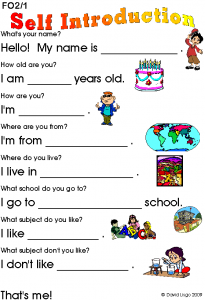There are many stories about different assumptions of ELL students, and sometimes being told a message over and over could influence our overall judgements with cloudy ignorant. It is important to know a few things about the myths and false believes of what we think its best.
- All ELL students came from a refugee or close to a refugee status.
In the 1999 ESL guideline, designed for the specialist and teachers, mentioned about the general four stages of adjustments – Honeymoon, hostile, humour, and home. What have changed significantly since that was written is that most of the immigrants that are coming into Canada will have a higher Social-Economic Status (SES) than the earlier immigrants or locals. This is solely due to the change in immigration law since 2001.
- Grammar-translation method is boring and therefore we should avoid it at all cost.
Being a first-hand experience source, I find that the simple achievable worksheet allows the non-readers and minimal writers to gain confidence by achievable goals. These are the students who just landed into Canada from China, India or relative cultural background where marks and validation of work is vital to their academic survival. With the lack of simple and repetitive work, students will feel more anxiety from the lack of understanding of language and culture than the abundance of, supposedly, non-developmental work.
Similarly, it is important to provide them with relative homework assignments, adapted according to their language level so that they can feel belongingness as everyone hand in assignments relative to the same subject that they are handing in.
- English acquisition is the responsibilities of the specialists not mine (as a teacher)
The reasoning behind encouragement of speaking native tongue at home and target language away from home is to differentiate language application in the work and survival from calm and casual environments. Thus, as the teacher, to your students, you are the working environment to your students’ life.
It is a recognized understanding, according to any psychological theory, that a person can’t learn what a person doesn’t want to learn. Sometimes, I think, a student is willing to take challenges, even seemingly impossible from the teacher than a specialist who, by profession, depicts the alienating factor between the ELL students from their peers.
- Pull-out method where all ELL are placed into a class is a bad idea.
This is not quite a myth, but I want to challenge this idea. Research and debates have been flaring up between the funding and allocation of funded resources. I realized with the amount of ELL students in the school system, they can actually run an ELL specific class to first allow the ELL students to learn how to converse in English with their friends. Otherwise, cliques are easily formed between language speakers amongst themselves pushing their English speaking opportunities to a minimal.
By being in an ELL specific classroom, students are assigned individual or group seating which can exercise independence of ELL students away from their language buddy – any student that speaks the same mother tongue. However, it does not exercise assimilation since it is recognized that during break time and free time, they could easy group together to have casual conversation.
- it’s too late for your older students to learn English as efficiently in comparison to the younger ones.
Language acquisition is actually better for adults due to the basic understanding of the more complex character traits of language applications. However, it is the familiarity of using the native tongue to solve problems that often leads the students to self-fulfilling prophesies of how it’s harder for older people.
Also, the expectation of language application for younger students are often much easier than older students. Grade 1 students, even as ELL, could easily catch up to their native English-speaking classmates in presentation, speaking, reading, and writing skills. Grade 2 students’ literacy PLOs are also much more achievable than say, a secondary level requirement to accomplishing the tasks they are expected to do. Thus, a grade 1 or 2 student may have begun to participate in class work with higher marks to validate their progress than a grade 9 or 10 student.
- Students with reasonable fluency can quickly pick up the academic work.
Fluency with social language, also known as Basic Interpersonal Communication Skills, could be easily mistaken as the fluency for functionality in Cognitive Academic Language Proficiency Skills. The social language is very fundamental and less comprehensive or critical of executive functioning. On the contrary, academic language requires the student to fully understand the interconnection between text and concept to relative problem solving logic with using the target language. This could take many years that run long beyond the year of social fluency.



When embarking on a construction project, one of the most important steps is ensuring that you have the elevation drawings for permits. These drawings provide a clear view of the building’s exterior from all sides, which is crucial for approval from local authorities. Not only do they show the height and placement of structures, but they also help ensure compliance with zoning laws and building codes.
Perfect tool for web, film, and design projects – the 4:3 calculatordoes the math for you.
A birth certificate check in Bangladesh can be done through the official BDRIS verification portal by entering your 17-digit Birth Registration Number and date